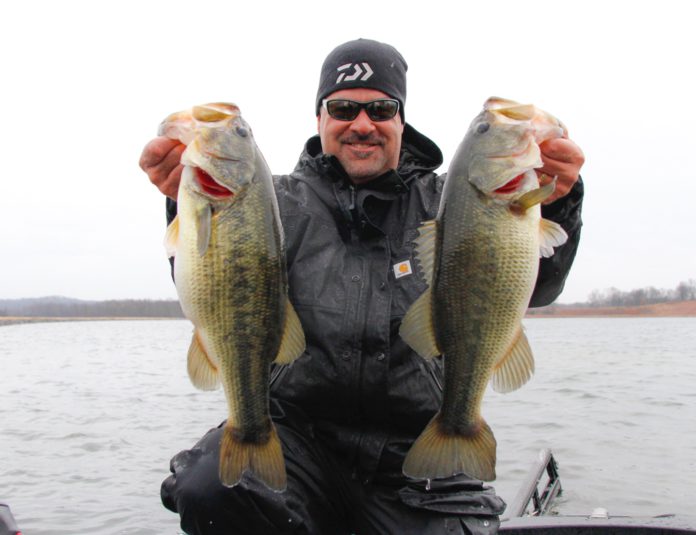
Covering water Mark Zona’s mainstay technique
BY PAUL LEBOWITZ
The drop-shot is a can’t miss trick for fall and winter bass. What if you could take this bread and butter and jazz it up? Bass fishing personality Mark Zona has done just that with the mainstay he calls “power-shotting.”
“This technique is taking on a life of its own because of the lake styles I fish,” he says. “They are vast, big and featureless.”
Like everyone else in the sport, Zona grew up fishing a standard drop-shot rig with weights between 1/8- to 3/8-ounce. He rarely does that anymore, preferring to use this innovation. The chief difference in power-shotting is the use of a much heavier weight.
“Seventy-five percent of the time I use 1/2- to 1 ounce,” he explains. “The beauty of it is I’m fishing a traditionally slow technique to efficiently and quickly cover water.”
How’s that work? The fall rate when power-shotting is much faster with the heavier weights. The point is to induce a reaction strike. “I call it plinking,” Zona says. “I make 20- to 30-foot pitches in front of my boat. They only have time to eat it or not, it falls like a bowling ball.”
In winter, you’ll want to find more active fish to try it out on more temperate waters.
Zona says he developed the technique after realizing bass usually bite the standard drop-shot on the initial fall. That’s true on Lake St. Clair, Erie or even Table Rock.
Think about it. With the heavier weights used for power-shotting, Zona gets squeezes a lot more casts into his fishing day. “The law of averages is I’m going to get my bait out there 30-40% more by the end of the day,” he says. “It’s staggering how efficient it is.”
Zona says he’s passed the technique along to a lot of anglers. Power-shotting works. “The more pressured the fish get, the more this technique really shines,” he says.
Let’s look at Mark Zona’s power-shotting rig.
The rod
Zona’s standard power-shotting technique employs a 7-foot, 3-inch Daiwa Tatula cork-handled rod. “The beauty of that rod, it’s very light but I like that the thing’s got a lot of backbone,” he points out.
“It has an ultra-soft tip but when I sweep on a biter, I can control the fish to where it doesn’t control me. I like that the rod’s a little bit longer. To me the extra length plays out in leverage, this is a big fish technique,” Zona adds.
The reel
Zona uses a Daiwa Tatula LT 3000 reel. It’s fast. “It can pick up a lot of line. With that rod, and this is no BS, I move a lot of line very quickly which is critical.”
According to Zona, “LT” stands for Light and Tough. He explains, “I fish very abusive water, some rough places, and kick the crap out of those reels. The conditions beat my reels down, but I’m fishing for bass that will test equipment.”
The line
This is simple. Zona likes 20-pound Seaguar Flash Green braid with 8-pound Seaguar AbrazX fluorocarbon leader.
The bait
Let’s start with the pointy end, a #2 or 1/0 Trokar drop-shot hook. For “lead,” it’s got to be Strike King Tour Grade tungsten drop-shot weights. They are rigged on standard drop-shot baits – Zona prefers hand-poured plastics. “Hands down, bar none, at the lakes I fish the primary forage is baitfish,” he says. “Alewife, emerald shiners, and shad. Recently I tied on Strike King Z2 and Baby Z2. They are the finest drop-shot baits on earth.”
Embrace the weight. “If you think you’re fishing a heavy weight on the drop-shot, go heavier, you’ll be stunned how many more bites you get,” Zona says.



